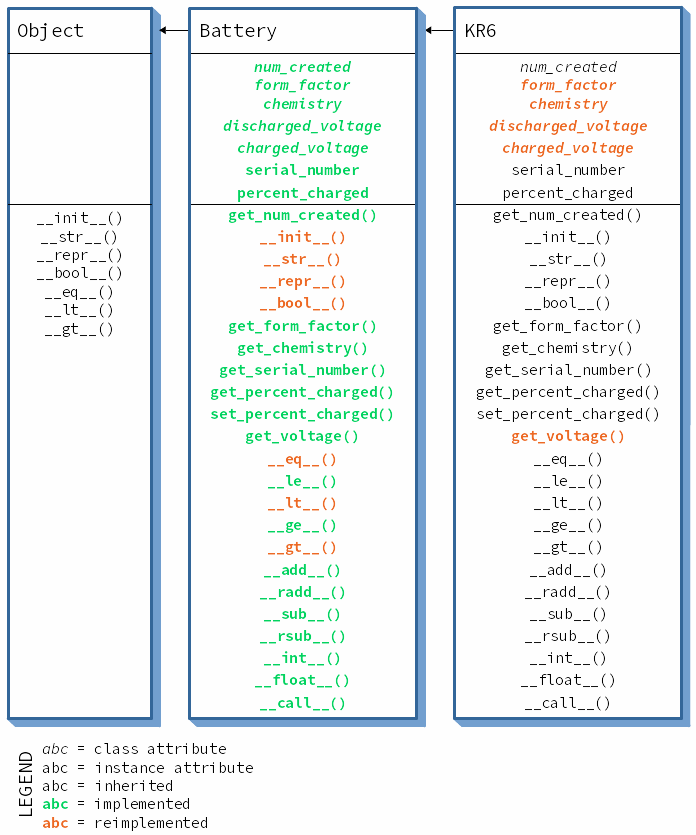Object-Oriented Programming Part-2¶
Indices and tables¶
Introduction¶
In the last topic, we defined a base class for batteries. Using inheritance, we can create different types of batteries, and specialize the characteristics of the base class battery to match.
KR6_Battery¶
The KR6 battery type is AA sized and uses NiCD chemistry. We can specialize the Battery base class for the KR6 battery as follows:
- Derive a new class from the Battery base class
- Reimplement the class variables with KR6 specific values
- Reimplement the
get_voltage()method with KR6 specific formula
1 2 3 4 5 6 7 8 9 10 11 12 13 14 15 16 | from Battery import Battery
class KR6(Battery):
# Specialize base class variables to this type of battery
form_factor = "AA"
chemistry = "NiCd"
discharged_voltage = 0.9
charged_voltage = 1.2
# Override the get_voltage() method to specialize it to
# this battery
def get_voltage(self):
# Linearly interpolate between fully discharged and
# fully charged voltages, based on percentage_charged.
delta_voltage = self.charged_voltage - self.discharged_voltage
return self.discharged_voltage + delta_voltage * (self.percent_charged / 100)
|
For very little work, we were able to create a new battery that took advantage of previously created logic for all but 5 of the class attributes. Fig. 49 represents the class diagram of the KR6 class that has been created:
And we can see the fruits of our labor, a customized battery type!
>>> #
>>> # Import the battery type
>>> #
>>> from BatteryOrigPkg.KR6 import KR6
>>> #
>>> # Create a KR6 battery
>>> #
batt0 = KR6("K7811")
>>> #
>>> # Get the eval'able form
>>> #
>>> repr(batt0)
'KR6("K7811", 0)'
>>> #
>>> # Get the human readable form
>>> #
>>> print(batt0)
0.9v (Charge:0% Size:AA Type:NiCd SN:"K7811")
>>> #
>>> # Change it's charge level
>>> #
>>> batt0.set_percent_charged(50)
>>> print(batt0)
1.05v (Charge:50% Size:AA Type:NiCd SN:"K7811")
>>> batt0.set_percent_charged(100)
>>> print(batt0)
1.2v (Charge:100% Size:AA Type:NiCd SN:"K7811")
HR14_Battery¶
The HR14 battery type is C sized and uses NiMH chemistry.
For this battery, we use an exponential curve to represent the discharge curve, which is easily handled using a customized get_voltage() method.
1 2 3 4 5 6 7 8 9 10 11 12 13 14 15 16 | from Battery import Battery
class HR14(Battery):
# Specialize base class variables to this type of battery
form_factor = "C"
chemistry = "NiMH"
discharged_voltage = 1.0
charged_voltage = 1.2
# Override the get_voltage() method to specialize it to
# this battery
def get_voltage(self):
# For this cell, the charge to voltage conversion follows
# a y=x^2 curve.
return (0.4472 * self.percent_charged / 100) ** 2 + self.discharged_voltage
|
Taking the HR14 battery for a spin…
>>> #
>>> # Import the battery type
>>> #
>>> from BatteryOrigPkg.HR14 import HR14
>>> #
>>> # Create a HR14 battery
>>> #
batt1 = HR14("AF4194", 35)
>>> #
>>> # Get the eval'able form
>>> #
>>> repr(batt1)
'HR14("AF4194", 35)'
>>> #
>>> # Get the human readable form
>>> #
>>> print(batt1)
1.0244985104v (Charge:35% Size:C Type:NiMH SN:"AF4194")
>>> #
>>> # Change it's charge level
>>> #
>>> batt1.set_percent_charged(50)
>>> print(batt1)
1.04999696v (Charge:50% Size:C Type:NiMH SN:"AF4194")
>>> batt1.set_percent_charged(100)
>>> print(batt1)
1.19998784v (Charge:100% Size:C Type:NiMH SN:"AF4194")
LR4_Battery¶
The LR4 battery type is AA sized using Alkaline chemistry. For this battery, the conversion from charge to voltage is based on a piecewise curve. Again, this is easily handled using a customized get_voltage() method.
1 2 3 4 5 6 7 8 9 10 11 12 13 14 15 16 17 18 19 20 21 22 23 24 25 26 27 28 29 30 31 32 33 34 35 36 | from Battery import Battery
class LR4(Battery):
# Specialize base class variables to this type of battery
form_factor = "AA"
chemistry = "Alkaline"
charge_curve = {0: 0.62,
10: 0.98,
20: 1.04,
30: 1.08,
40: 1.10,
50: 1.12,
60: 1.16,
70: 1.20,
80: 1.27,
90: 1.35,
100: 1.49}
discharged_voltage = charge_curve[0]
charged_voltage = charge_curve[100]
# Override the get_voltage() method to specialize it to
# this battery
def get_voltage(self):
# Interpolate along the charge_curve, based on the
# percentage charged, to get the output voltage.
# Start by finding the lower and upper bounds in the
# charge_curve table to interpolate over
lower = (self.percent_charged // 10) * 10
if self.percent_charged == 100:
upper = 100
else:
upper = (self.percent_charged // 10 + 1) * 10
# Interpolate between the lower and upper bounds
return self.charge_curve[lower] + \
(self.charge_curve[upper] - self.charge_curve[lower]) * (
upper / 100 - self.percent_charged / 100)
|
Taking the LR4 battery for a spin…
>>> #
>>> # Import the battery type
>>> #
>>> from BatteryOrigPkg.LR4 import LR4
>>> #
>>> # Create a LR4 battery
>>> #
batt2 = LR4("GK245-01", 25)
>>> #
>>> # Get the eval'able form
>>> #
>>> repr(batt2)
'LR4("GK245-01", 25)'
>>> #
>>> # Get the human readable form
>>> #
>>> print(batt2)
1.042v (Charge:25% Size:AA Type:Alkaline SN:"GK245-01")
>>> #
>>> # Change it's charge level
>>> #
>>> batt2.set_percent_charged(50)
>>> print(batt2)
1.124v (Charge:50% Size:AA Type:Alkaline SN:"GK245-01")
>>> batt2.set_percent_charged(100)
>>> print(batt2)
1.49v (Charge:100% Size:AA Type:Alkaline SN:"GK245-01")
Playing with Batteries¶
Above, we created 3 batteries (one for each type). Lets try out the various operations on them:
>>> #
>>> # Getting properties of the battery
>>> #
>>> batt0.get_num_created()
3
>>> # Remember, the instance counter is
>>> # on the base class and was never
>>> # reimplemented, so, '3' makes sense.
>>> # because we made 3 batteries.
>>> #
>>> batt0.get_form_factor()
'AA'
>>> batt0.get_chemistry()
'NiCd'
>>> batt0.get_serial_numer()
'K7811;
>>> batt0.get_percent_charged()
100
>>> batt0.get_voltage()
1.2
>>> batt1.get_voltage()
1.1998784
>>> batt2.get_voltage()
1.49
>>> #
>>> # Comparison Operations
>>> #
>>> batt0 == batt1
False
>>> batt0 != batt1
True
>>> batt0 <= batt1
False
>>> batt0 < batt1
False
>>> batt0 >= batt1
True
>>> batt0 > batt1
True
>>> #
>>> # Numerical Operations
>>> #
>>> batt0 + batt1
2.3999878399999997
>>> batt0 - batt2
-0.29000000000000004
>>> int(batt0)
1
>>> float(batt0)
1.2
